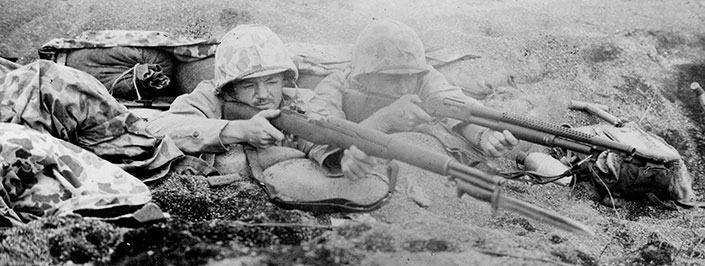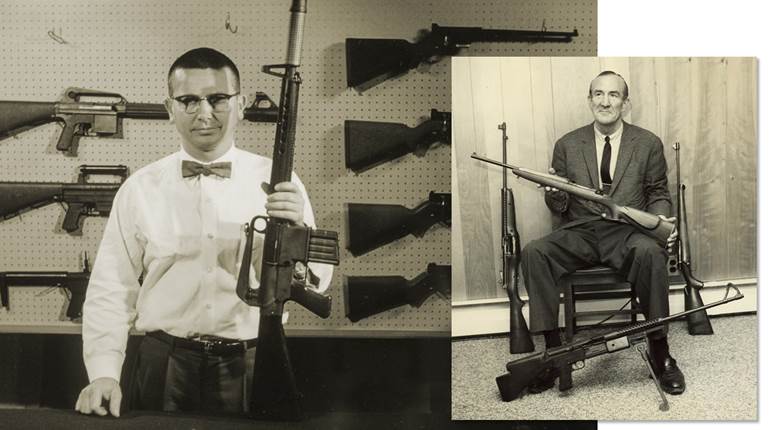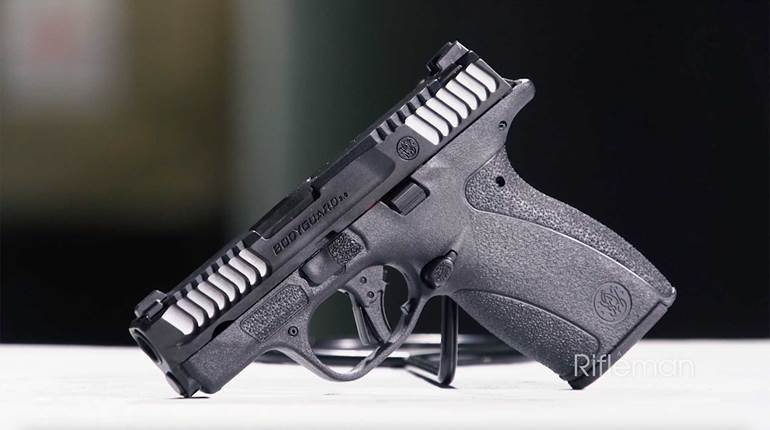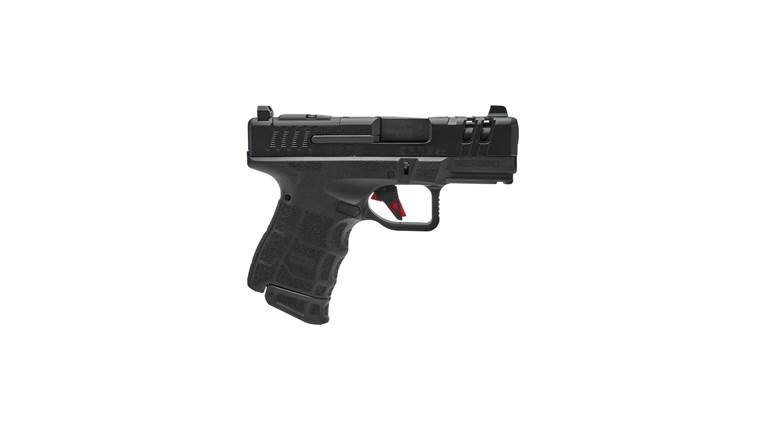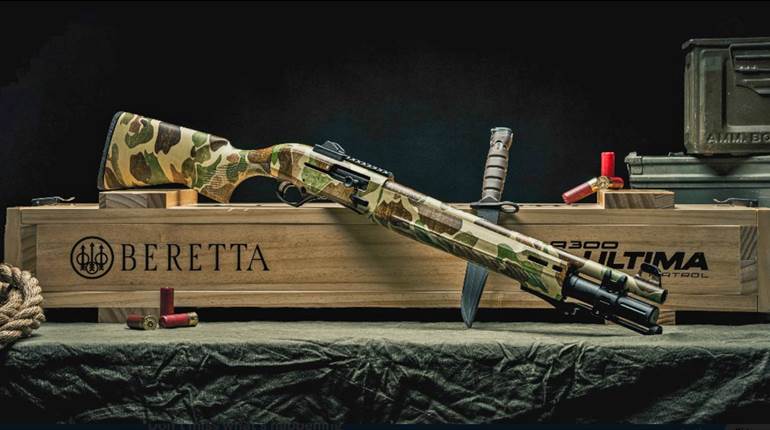
Winchester made 818,072 M1 carbines from 1942 until 1945. They saw service in all theaters, including with the Marines in the Pacific.
The Winchester Repeating Arms Co. has long been one of the most famous and respected makers of finely crafted and well-designed firearms for generations of sportsmen, shooters and collectors. Given the enviable reputation that Winchester has garnered with its sporting arms, the contributions the company has made during wartime are sometimes overlooked.
The forerunner of the lever-action Winchester rifle was the Henry rifle, which saw limited use during the Civil War. Soon after the Winchester Repeating Arms Co. was officially organized in late 1866, the company sought to interest the U.S. government in its Model 1866 lever-action rifle. The Ordnance Dept. tested the Model 1866 and some subsequent models, but the American military never embraced the company’s signature lever-action rifles.
Winchester manufactured several models of the bolt-action Hotchkiss rifles and carbines under government contract from 1878 to 1885 in rather limited numbers. Just prior to the Spanish-American War, Winchester manufactured the Model 1895 6 mm Lee Navy straight-pull bolt-action rifle, which saw limited service in the Spanish-American War, the Philippines and the Boxer Rebellion in China before being withdrawn from U.S. military service circa 1900. Due to a shortage of Krags during the Spanish-American War of 1898, the Ordnance Dept. ordered 10,000 Winchester Model 1895 lever-action “muskets” in .30-40 Krag, but the conflict ended before manufacture was completed. One hundred of these rifles were subsequently field tested by the U.S. Army in the Philippines, but the test reports were universally negative, and the rifles were sold as surplus.
Even into the first decade of the 20th century, the government-owned-and-operated facilities of Springfield Armory and Rock Island Arsenal could meet the demand for military small arms. Winchester continued to concentrate on its profitable line of commercial rifles and shotguns. After war erupted in Europe in 1914, the demand for military arms resulted in many American gunmakers being deluged with orders from foreign nations. Winchester produced a large quantity of Pattern 1914 .303 British bolt-action rifles for the British government. When the United States entered the war in the spring of 1917, Winchester manufactured U.S. Model 1917 rifles, Model 1897 and Model 12 shotguns and Model 1918 Browning Automatic Rifles through early 1919. After these contracts were completed, the company resumed production of guns for the civilian market. Such was the case for the next couple of decades—until the clouds of war began to gather again over Europe in the late 1930s.


The M1 Garand Rifle
In 1936 the semi-automatic M1 Garand rifle was adopted by the United States, and it was put into production at Springfield Armory. In the increasingly likely event the United States should become involved in another war, the War Dept. sought to augment Springfield’s M1 production. On June 19, 1938, the “Educational Order Act” was enacted, which authorized the Secretary of War to “place orders with commercial firms to familiarize them with techniques of manufacturing ‘munitions of war of special or technical design’ … non-commercial in character.” Under the provisions of the act, the War Dept. sought to issue an Educational Order contract to a civilian firm for the M1 rifle. Winchester was the successful bidder, and was granted a contract in March 1939 for 500 M1s. The first Winchester-made M1s were completed on Dec. 27, 1940, and the final batch made under the Educational Order was delivered on March 12, 1941. Even before the first 500 rifles were completed, Winchester received additional orders, and, by June 1945, had manufactured a total of 520,492 M1 rifles. In addition to manufacturing M1s, Winchester produced a large number of the rifle’s eight-round en bloc clips.
It was indeed fortuitous that both Winchester and Springfield Armory had their M1 rifle production lines up and running by the time of the attack on Pearl Harbor. The Winchester Garands and their Springfield Armory-made counterparts were vital components of America’s small arms arsenal during World War II and provided valuable service to our armed forces in all theaters of the war.
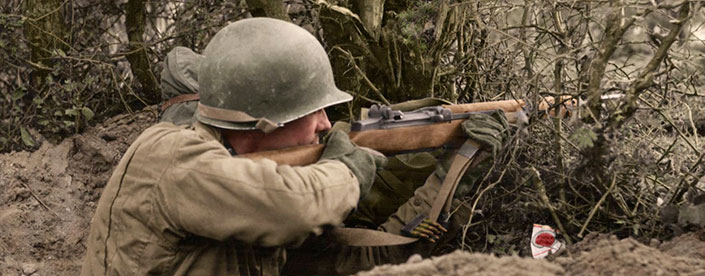

The M1 Carbine
The successes of the German Blitzkrieg in the early stages of World War II resulted in the perceived need for an arm light enough to be carried by ostensibly non-combat personnel, yet have more effectiveness than a pistol, which was essentially useless at a distance of more than a few dozen yards. In early 1940, the War Dept. issued orders for the development of such a gun. Before selecting a “Light Rifle,” the Ordnance Dept. had to determine the type of cartridge for which it would be chambered.
In the fall of 1940, the Ordnance Dept. consulted with Winchester, then a subsidiary of the Western Cartridge Co., on the proposed new cartridge. Winchester suggested that a cartridge similar to the .32 Winchester Self-Loading (WSL) round be the basis for the desired new cartridge. Ordnance concurred with the recommendation, and any potential guns submitted for consideration would be required to be chambered for this round. Prototypes were submitted for testing in May 1941, but none proved successful, and a second round of testing was scheduled for later in the year. Conspicuous by its absence was Winchester. The company was obviously aware of the Light Rifle project, but was heavily involved in getting its M1 Garand production line in operation and apparently didn’t want to invest the capital or engineering commitment necessary to submit a design for the Light Rifle trials.
Army Ordnance Col. Rene R. Studler personally requested Winchester submit a design for the upcoming tests, and the company was able to fabricate a working model in only 13 days! The hastily-built prototype functioned well during the tests, but, like the others tested, some improvements were necessary, and a third round of testing was scheduled for September 1941. Winchester manufactured an improved prototype Light Rifle for this last round of tests. During the course of the testing, the field was narrowed down to the Winchester and a design developed by John C. Garand. Eventually, the Winchester design was the hands-down winner of the competition. The trim little semi-automatic rifle weighed just more than 5 lbs. and was 35.6" in length overall.
On Sept. 30, 1941, the Winchester design was recommended for adoption as the “U.S. Carbine, Caliber .30, M1.” The U.S. Army finally had its new Light Rifle, and the timing couldn’t have been better as the Japanese attack on Pearl Harbor was less than three months away.
The carbine was a new class of arm, and demand soon proved to be far greater than originally projected. Eventually, Winchester and nine other civilian firms received production contracts. Winchester’s first deliveries of carbines to the government were in October 1942. It is worthy of note that, of those firms, Winchester was the only carbine prime contractor to have manufactured firearms prior to World War II.
In addition to the standard M1 carbine, Winchester produced a selective-fire version, the M2 carbine, which went into production in mid-1945. Winchester also manufactured a limited number of semi-automatic “T3” carbines, which had a special receiver modified for use with an infrared night vision scope. The T3 saw issuance in the closing stages of the Pacific War.
More than 6 million carbines were manufactured by the time production ended in 1945. Winchester produced 818,072 M1 carbines, along with 17,500 M2s and 1,108 T3s, which represented just over 13 percent of the total number of carbines manufactured. The only prime contractor that made more carbines than Winchester was the Inland Mfg. Division of General Motors.
The carbine proved to be an “ace” arm of the war, and was used by all branches of the service in all theaters. A document from the War Dept. read, “Army Ordnance officers state the carbine is one of the most popular weapons they have ever issued to the service.”

Military Shotguns
The combat shotgun was a uniquely American arm. A version of Winchester’s popular Model 1897 slide-action repeating shotgun was developed for close-quarters warfare in the trenches of France during World War I. Dubbed the “Trench Gun,” it was a standard 12-ga. pump-action
Model 1897 20"-barreled “riot gun” fitted with a ventilated metal handguard, bayonet adapter assembly and sling swivels. The bayonet adapter, developed jointly by Winchester and Springfield Armory, was designed for use with the Model 1917 rifle bayonet. The trench guns were used with notable effectiveness in the closing months of World War I. The Model 1897 remained the standard American military combat shotgun in the post-World War I era.

During World War II, Winchester again produced a trench gun version of the Model 97 for the American military. The company also made a plain-barrel riot gun intended primarily for sentry duty, along with a longer-barrel model used for training aerial gunners and for recreational purposes.
Another popular shotgun in Winchester’s product line was the slide-action Model 12. During World War II, Winchester manufactured Model 12s in trench gun, riot and training variants under government contracts. The Winchester Model 97 and Model 12 trench guns were the primary combat shotguns used by the American military during the war. They proved to be valuable close-quarters-combat arms, primarily in jungle warfare, and also were widely used for guard and security purposes.


Model 70 Rifle
Another popular Winchester civilian firearm was the bolt-action Model 70 rifle. In early World War II, it was proposed by a U.S. Marine Corps Equipment Board that a Model 70 in .30-’06 Sprg. fitted with a target-type telescope manufactured by the Unertl Co. be procured as a sniping rifle. The commandant rejected the Model 70/Unertl sniper rifle in favor of a match-tuned Springfield Model 1903 rifle, but approved procurement of the Unertl scope. The government did acquire a limited number of Model 70 rifles for recreational use during the war, and a few unofficially found their way overseas into combat zones.

Winchester Prototypes
While the company produced large numbers of M1 Garand rifles, carbines and shotguns—along with a few Model 70 rifles for the military during the war—Winchester also developed, in-house, several other types of firearms with the hope that the government might be interested in them to replace, or supplement, the standardized guns.
Although Winchester was in production of the M1 rifle, company engineers and management were never enamored with the Garand and sought to develop a proprietary semi-automatic rifle. Designated as the “G30,” it was tested by the Marine Corps in 1940 against the Garand and Johnson rifles. While it showed some promise, it did not perform as well in the testing as the other two, and no orders were forthcoming. The company developed an improved version, the “G30R,” but, again, the government wasn’t interested in any semi-automatic service rifle other than the M1 Garand.
Winchester also developed a version of the M1 rifle capable of selective-fire operation and fitted with a 20-round detachable box magazine. However, John Garand had designed a very similar prototype rifle at Springfield Armory, and the Ordnance Dept. expressed little interest in the Winchester version.

In addition to the semi-automatic rifle prototype, Winchester also developed a selective-fire version of the G30R configured as a squad automatic rifle. The standardized Browning Automatic Rifle was a capable design, but was showing its age. Winchester believed its Winchester Automatic Rifle (WAR) would be an improvement over the venerable BAR. The WAR was tested by the Ordnance Dept. in late 1944. The results of the testing were promising; 10 WARs were ordered and additional tests were scheduled to be held at the Aberdeen Proving Ground in June 1945. But the war ended just a couple of months later, and the concept of a replacement for the BAR was dropped, much to Winchester’s chagrin.
Interestingly, at about the same time the WAR was under development, Winchester also fabricated a massive semi-automatic rifle chambered for the potent .50 BMG (Browning Machine Gun) cartridge utilizing what was essentially a scaled-up M1 Garand action. It was reportedly developed at the behest of the Canadian government for possible use as a man-portable anti-tank arm. By this time, though, the .50 BMG cartridge was deemed inadequate against the armor of most enemy tanks, and further refinement was shelved. It was tested in late 1944, but no record of the test results has been discovered, and apparently only a single prototype example was built. Nevertheless, it illustrates that Winchester continued to think outside the box throughout World War II regarding small-arms innovation.

Small-Arms Ammunition
Winchester’s contributions to America’s war efforts during World War II were not limited to the development and manufacture of firearms. In 1931, the Western Cartridge Co. acquired the assets of the Winchester Repeating Arms Co. and operated the firm as a subsidiary of WCC. Although Western Cartridge Co. manufactured large quantities of ammunition for the U.S. War Dept. in World War II, its Winchester subsidiary also produced a significant amount of ammunition for Uncle Sam. Since the company’s .32 WSL cartridge was the basis for the .30 Carbine cartridge, it is not surprising that Winchester also manufactured carbine ammunition from 1942 through 1945. In addition, the company produced substantial quantities of M2 .30-cal. ball rifle ammunition as well as 12-ga., 00 buckshot shells, both paper-cased and all-brass types.

Throughout its long and illustrious history, Winchester Repeating Arms Co. has garnered a well-deserved reputation as one of America’s premier firearm manufacturing companies. An important, if sometimes overlooked, part of the iconic company’s legacy was its production of vitally needed armaments at arguably the most critical time in the history of the United States, the life-and-death battle against the foes of freedom known as World War II.
